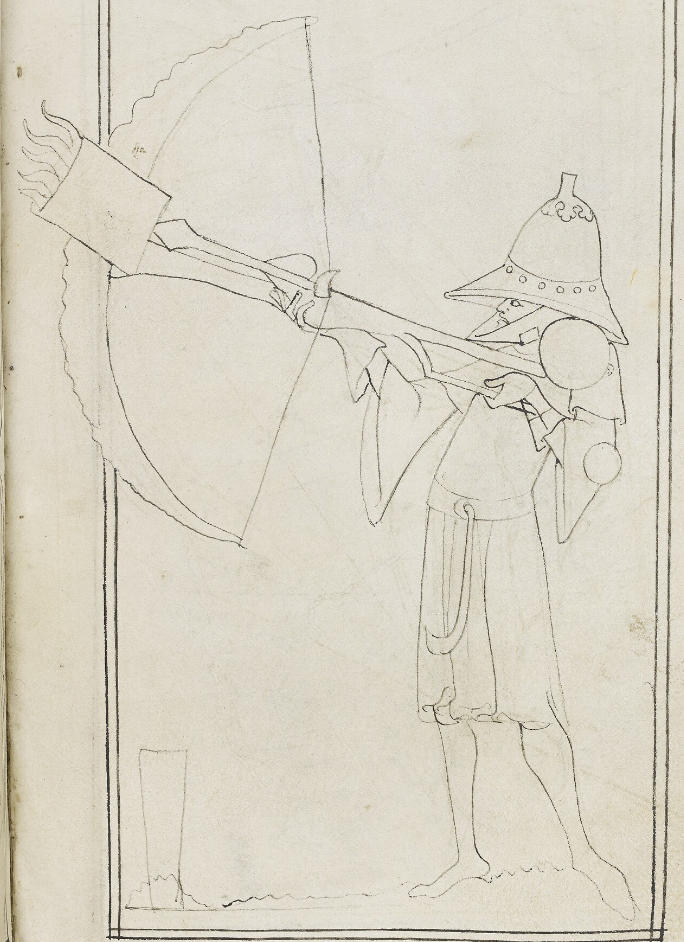Create an Amazon Business Account

Join Amazon Prime - Watch Thousands of Movies & TV Shows Anytime - Start Free Trial Now
Treatise of Walter de Milemete, London, England, 1326-1327
An English crossbowman wearing a 'chapel de fer' and 'barbote' on folio 76r

A bowman with a flaming pot attached to his bolt
Title: De Nobilitatibus, Sapientiis, et Prudentiis Regum
Creator: Walter de Milemete [author]
Shelfmark: Christ Church MS 92
Date: 1326 - 1327
Language: Latin
Collection: Western Manuscripts
Description: Walter de Milemete wrote his book on the nobility, wisdom and prudence of kings as an offering to King Edward III at the end of 1326.
An ambitious project, the text is dominated by the decorative borders, crammed with heraldry, contorted hybrids, combats between man and man, man and beast,
half-man and half-beast, hunting scenes and tournaments.
It is one of the most beautifully illuminated manuscripts in the world and one in the highest demand by specialists.
Source: Christ Church, Oxford
Referenced as figure 223 in Arms and Armour of the Crusading Era, 1050-1350, Western Europe and the Crusader States by David Nicolle.
223A-M Treatise of Walter de Milemete, London, c.1326
(Christ Church Library Ms. E. 11, Oxford, England)
The early illustration of a cannon in Walter de Milemete’s treatise on Nobility, Wisdom and the Prudence of Kings
has tended to divert attention away from other interesting pieces of armour and weaponry in this manuscript.
The picture of a gun (A) is perhaps slightly more accurate than has sometimes been thought.
Small bottle-shaped bronze hand-guns of more elongated form than the object shown here were apparently mounted on shafts about a metre long.
The large cannon in the Milemete illumination seems to be based on such small guns.
Perhaps these were the only firearms with which the artist was familiar.
In reality, larger early cannon were generally tubular in shape, being built up of strips and hoops of iron.
Nor were they, of course, mounted on flimsy trestles as shown here.
All firearms were almost certainly fired by a red-hot metal touche, as shown in this manuscript.
Other interesting pieces of arms and armour in Walter de Milemete’s treatise include a round-topped great helm with a movable visor (B).
Such helmets may, at least as far as their visors are concerned, be seen as a transitional stage leading to the later visored bassinet.
Other helmets include a large and almost pointed great helm with a crest (C), a tall and broad-brimmed chapel de-fer war-hat
of somewhat Germanic form (D), and many close-fitting cervelliéres or early bassinets (E-G and I-M).
Another figure (D) also has an early example of a throat-covering barbote.
Such a piece of armour would become popular in various parts of 15th-century Europe but at this period seems mostly to have been limited to Italy and the Balkans.
Mail hauberks with mittens and coifs are seen (E, F, H and J-M).
Roundels protect some shoulders (C-G and M) while rectangular ailettes are seen twice (H and I).
One or two men have roundels at their elbows (D and E) and tubular arm defences are shown in a somewhat rudimentary manner (E-G), as are greaves (E, H, M and K).
A series of small circles might indicate a coat-of-plates worn by a figure without a surcoat (I).
This figure also shields himself with a large round-based infantry mantlet.
Spears are widely used, but another foot soldier also carries a spiked weapon with a hook at the back (K).

For terms in italics see Terminology in Armour of the Crusading Era, 1050-1350 - Western Europe and the Crusader States - David Nicolle
Back to the Treatise of Walter de Milemete, London, England, 1326-1327AD


